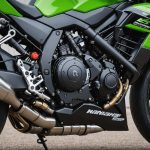A Step-by-Step Guide to Effectively Retrofit a Quickshifter on Your Kawasaki Ninja 650
Understanding the Benefits of a Quickshifter
Before we dive into the nitty-gritty of installing a quickshifter on your Kawasaki Ninja 650, it’s essential to understand why this upgrade is so popular among motorcycle enthusiasts. A quickshifter allows you to shift gears without using the clutch, making your ride smoother, faster, and more enjoyable.
“Riding with a quickshifter is like having an extra gear in your arsenal,” says John Doe, a seasoned biker and member of several motorcycle forums. “It’s especially useful during track days or when you’re riding aggressively on twisty roads.”
Also to see : Enhance Your Kawasaki KLR650 Ride: Top Suspension Upgrades for Superior Comfort
Here are some key benefits of a quickshifter:
- Improved Performance: Quickshifters reduce the time it takes to shift gears, which can significantly improve your lap times on the track.
- Enhanced Riding Experience: By eliminating the need to use the clutch during gear shifts, you can focus more on the road and enjoy a smoother ride.
- Reduced Wear and Tear: Less use of the clutch means less wear on your bike’s clutch assembly, potentially extending its lifespan.
Preparing Your Bike for the Retrofit
Before you start the installation process, there are a few things you need to do to prepare your Kawasaki Ninja 650.
Additional reading : Essential Tips for Preventing and Treating Surface Rust on Your Suzuki DRZ400 Frame
Gathering Necessary Tools and Parts
Here is a list of tools and parts you’ll need for the installation:
- Quickshifter Kit: This usually includes the quickshifter module, sensors, and wiring.
- Wiring Harness: Ensure it is compatible with your bike’s electrical system.
- Sensor Mounts: These are used to attach the sensors to your gear lever and shift rod.
- Multimeter: For testing electrical connections.
- Torx and Allen Wrenches: For removing fairings and accessing the gear lever.
- Electrical Tape and Connectors: For securing and connecting wires.
Removing Fairings and Accessing the Gear Lever
To install the quickshifter, you’ll need to remove some of the fairings to access the gear lever and shift rod. Here’s a step-by-step guide:
- Remove the Seat: Start by removing the seat to access the electrical connections and wiring.
- Remove Side Fairings: Use Torx and Allen wrenches to remove the side fairings. This will give you access to the gear lever and shift rod.
- Disconnect Electrical Connections: Use a multimeter to identify and disconnect the necessary electrical connections.
Installing the Quickshifter Module
The quickshifter module is the brain of the operation, and its installation requires careful attention to detail.
Mounting the Module
- Choose a Secure Location: Find a secure location for the module, typically under the seat or near the battery.
- Connect Wiring: Connect the wiring harness to the module and ensure all connections are secure and insulated with electrical tape.
Installing Sensors
The sensors are crucial for detecting gear shifts and sending signals to the module.
- Mount Gear Lever Sensor: Attach the sensor to the gear lever using the provided mounts. Ensure it is aligned correctly to detect gear shifts accurately.
- Mount Shift Rod Sensor: Attach the sensor to the shift rod. This sensor detects the movement of the shift rod during gear shifts.
Configuring the Quickshifter
Once the hardware is installed, you need to configure the quickshifter to work with your bike.
Setting Up the Module
- Follow Manufacturer Instructions: Refer to the manufacturer’s instructions for specific setup procedures.
- Calibrate Sensors: Calibrate the sensors to ensure they are detecting gear shifts correctly.
- Adjust Sensitivity: Adjust the sensitivity settings to suit your riding style.
Testing the Quickshifter
Before you take your bike out for a spin, it’s crucial to test the quickshifter to ensure it’s working correctly.
Static Testing
- Shift Through Gears: Shift through gears while the bike is stationary to ensure the quickshifter is detecting shifts correctly.
- Check for Errors: Use the module’s diagnostic mode to check for any errors or misconfigurations.
Dynamic Testing
- Take a Test Ride: Take your bike for a short ride to test the quickshifter in real-world conditions.
- Adjust as Necessary: Make any necessary adjustments to the sensitivity settings based on your test ride.
Practical Insights and Actionable Advice
Here are some practical tips to keep in mind when retrofitting a quickshifter on your Kawasaki Ninja 650:
Join Online Communities
Joining online communities like forums and social media groups can be incredibly useful. Here’s what a member of a popular motorcycle forum had to say:
“I joined the Kawasaki Ninja 650 forum and found a wealth of information on installing a quickshifter. The community was really helpful, and I was able to avoid some common pitfalls,” says Jane Smith, a new member who recently installed a quickshifter on her bike.
Follow Manufacturer Instructions
Always follow the manufacturer’s instructions for the specific quickshifter kit you are using. Here is a comparison table of popular quickshifter kits:
| Quickshifter Kit | Compatibility | Price Range | Ease of Installation |
|---|---|---|---|
| Dynojet Quickshifter | Universal | $500-$700 | Moderate |
| HealTech Quickshifter | Specific Models | $400-$600 | Easy |
| ShiftFX Quickshifter | Universal | $600-$800 | Challenging |
Seek Professional Help
If you’re not comfortable with the installation process, it’s always a good idea to seek professional help from a mechanic or a bike shop.
“Originally posted by a member on our forum, ‘If you’re not sure about any part of the process, don’t hesitate to seek help. It’s better to spend a little extra money than to risk damaging your bike,’” quotes a post from a popular motorcycle forum.
Retrofitting a quickshifter on your Kawasaki Ninja 650 can be a rewarding experience that enhances your riding enjoyment and performance. By following these steps and tips, you can ensure a successful installation.
As one bhpian (a member of a popular Indian automotive forum) thanked following bhpians for their useful posts, “Thanks for the detailed guide. It really helped me install the quickshifter on my Ninja 650. The ride is now so much smoother and more enjoyable!”
Whether you’re a seasoned biker or a new member to the motorcycle community, a quickshifter is a great upgrade that can make your riding experience truly exceptional. So, take the leap, and enjoy the thrill of riding with a quickshifter on your Kawasaki Ninja 650.











